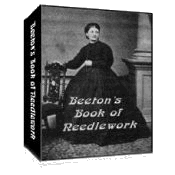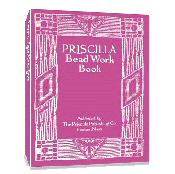Chain Stitch Variations
There are a number Chain Stitch variations which may be used by themselves for filling large shapes, or as line stitches which can be used successfully for working an entire embroidery item. There are also variations of the chain stitch which may be used for working broad bands.
Zigzag Chain |
Twisted Chain |
Double Chain |
Double Chain 2
Open Chain |
Chequered Chain |
Cable Stitch |
Cable Stitch 2
Lazy Daisy Stitch |
Wheat Ear |
Single Wheat Ear |
Continuous Wheat Ear
Whipped Chain |
Broad Stitch |
Raised Chain Band |
Backstitched Chain
Single Reverse Chain Stitch |
Double Reverse Chain Stitch |
Rope Stitch
Tambour Stitch |
Zigzag Chain.
The Zigzag Chain is worked in a similar way to chain stitch, but the stitches are made between two lines. Insert the needle first on the right side and then on the left to form a border, as in the illustration below.

Click on picture to see more detail.
Twisted Chain.
The Twisted Chain is like the simple chain stitch, but instead of the needle being inserted in the loop it is placed to the left and to the outside of the last loop.

Click on picture to see more detail.
Double Chain.
The Double Chain Stitch may be recommended as the most elegant edging or appliqué figures. The stitch looks complicated but is in reality very simple, when understood.
It consists of two rows of Common Chain stitching laid parallel and connected by a third thread which laces the inner loops of the two rows by an over and over stitch. See illustration below.

Click on picture to see more detail.
The effect of this work is very pretty when the lines of chain stitches are laid half an inch apart and connected by a contrasting color.
Double Chain 2.
This is a useful stitch for bands. It is worked with a chain stitch movement from side to side between a double line about ¼ inch apart. The width of the band is determined by the thickness of the thread. Insert the needle in the last loop, first on one line and then on the other, alternately forming triangular loops, as in the illustration below

Click on picture to see more detail.
Open Chain.
The Open Chain is another stitch suitable for bands and which is worked between two lines. The needle is inserted in the loop, first on one side and then on the other with a chain stitch movement. The needle emerges immediately below where it is inserted and the making of the next stitch pulls the loop into a square shape.

Click on picture to see more detail.
Chequered Chain.
This is worked with two threads of different colours, both threaded into the same needle. As the name implies, one loop is of one colour and the next of the other. Pass one thread at a time under the needle to form the loop. The colours are used alternately to give a chequered effect.

Click on picture to see more detail.
Cable Stitch.
The Cable Stitch is made in the same manner as the Chain Stitch, except that the needle is inserted to the right and a little below the loop preceding, instead of inside. This leaves the links open and gives the name of Cable Stitch. See illustration below.

Click on picture to see more detail.
Cable Stitch 2.
In appearance the Cable Chain is like the ordinary chain stitch with a single stroke between each loop. The first stitch of this chain stitch variation is made as ordinary chain. To make the second and subsequent loops work as follows: make a twist in the thread with the point of the needle which is inserted in the line of sewing just below the last loop made. Pass the thread under the needle point, and pull the thread through.

Click on picture to see more detail.
Lazy Daisy Stitch.
This stitch is also known as the Link Stitch. A single chain stitch tied down with a small stitch. This stitch may be used singly to form a spot pattern over a large area or may be clustered together to make small flowers.

Click on picture to see more detail.
Wheat Ear.
The Wheat Ear is a combination of the Lazy Daisy Stitch and the Fly Stitch worked together to form a wheat ear design. They may be worked individually as a spot motif or as a continuous line, as shown in the illustration below. This stitch is suitable for working leaves and grasses.
Single Wheat Ear.
A fly stitch is made first; this is like a lazy daisy stitch opened out. A lazy daisy stitch is then worked with the tips of the loops hooked into the base of the fly stitch. See illustration below.
 Continuous Wheat Ear.
Continuous Wheat Ear.
This stitch is worked between two parallel lines. The ears of the stitch are made first with two single stroke stitches. Bring the thread through in the center of the lines and pick up a horizontal stitch from left to right, inserting the needle in the left-hand line and bringing it out immediately opposite on the right-hand line (Fig. No.1). These three points should form a triangle. Pull the thread through and insert the needle again where the thread emerged, bringing it out immediately below this point, see Figure No. 2. The size of this last stitch should be the same as the two stroke stitches. Next, slip the needle under the stroke stitches from right to left (see Figure No. 3). Complete the movement by picking up a diagonal stitch parallel with the first stroke stitch (see Figure No. 4). The first stroke stitch of the next and subsequent wheat ears are made by inserting the needle at the base of the last loop, (Figure No.5).

Click on picture to see more detail.
Whipped Chain.
The Whipped Chain is a decorative rope-like stitch which consists of a line of ordinary chain stitch whipped with another colour, as shown in the following illustration.
 Broad Chain.
Broad Chain.
The Broad Chain should be worked with a firm thread or the finished result will be spidery. To work this chain stitch variation, start at the top and make a small running stitch along the sewing line, bringing the needle out the length of the broad chain below the running stitch. Slip the needle under the running stitch or previous chain, from left to right (see Figure No. 1), and insert it again in the place where it last emerged picking up another stitch along the line for the beginning of next stitch (see Figure No. 2). In this stitch, there should be a line of back stitch on the wrong side.

Click on picture to see more detail.
Raised Chain Band.
The Raised Chain Band is a good border stitch which is worked on a basis of straight threads made at right angles to the direction of the border. Insert these threads first, making them about 1/16 in. or more apart, according to the thickness of the thread (Fig. No. 1). Start at the top and work downwards, making a chain stitch on each thread. The needle is slipped up under the thread on the left and down under the thread on the right, with the loop thus formed passing under the needle point (Figure No. 2). Then slip the needle up to the left under the next thread. This forms the tying-down stitch and the commencement of the next loop. If the foundation threads are worked farther apart, the finished effect will be more open, (Fig. No. 3). A contrasting shade can be used for the chain to give added interest.

Click on picture to see more detail.
Backstitched Chain.
This chain stitch variation is an interesting variety of chain stitch, especially if worked in thick thread. First work a line of chain, then, with a contrasting colour, make a line of back stitch down the center (see illustration below).

Click on picture to see more detail.
Single Reverse Chain Stitch
With the Single Reverse Chain Stitch we obtain the same effect as in the Common Chain Stitch, but the method and direction of working it is reversed, hence its name. To work this particular chain stitch variation, first make a short stitch at the farther end of the outline and send the needle up the length of a stitch below. Pass the needle through this stitch, but not through the fabric and insert it at the left of and close beside the point at which it was drawn out. Bring the needle out again the length of a stitch below, pass it back of the previous loop and send it down again as before, and so continue the length of the outline. If the needle splits the silk when you pass it beneath the loop, send the eye of the needle through first instead of the point.

DDouble Reverse Chain Stitch.
To form the Double Reverse Chain proceed in the same way to the point of the first “Single Reverse Chain Stitch,” but instead of sending the needle down the distance of a stitch below, insert it the same but bring it out just to the right or at about the point where the thread leaves the fabric. Draw this tiny through and pass the needle again back of the simple stitch, thus forming a double loop. Send it down again on the point to the left of the start and out the length of a stitch below on the outline. The next stitches are taken in the same way, passing the needle back of the loops as in the first case back of the simple stitch.

Click on picture to see more detail.
Rope Stitch
This stitch is a chain stitch variation but it may not seem apparent when looking at it. Once the stitch is begun, it is quite obvious that it is.
Rope Stitch gives a heavy twisted effect, which is much richer than any of the other Chain Stitches.
This chain stitch variation is commenced by the same kind of a loop as the Common Chain Stitch The succeeding stitches are taken by sending the needle down to the left and back of the loop instead of through it. Bring the needle out to the right and form the loop as in common chain. This makes a beautiful raised outline. The effect is not unlike that of a couched cord. It is moreover strong and therefore appropriate where a couched cord would not be. See illustration below.

Tambour Stitch
The Tambour Stitch, although classified as a Chain Stitch variation, can scarcely be classed strictly as an embroidery stitch, although it is sometimes employed in Turkish embroidery. It is the usual Chain Stitch, but worked through the fabric by means of a fine crochet hook.
As you can see, the Chain Stitch is a very propular and versatile stitch. Because it is so versatile, it is a stitch that embroiderers love to experiment with. There may be as many Chain Stitch variations as there are imaginative embroiderers. No matter if you use a tried and true variation like one of those above, or one of your own invention, it is sure to add beauty to anything to which it is applied.
Return to top of Chain Stitch Variations page.
Return to Embroidery Stitches
Return to Home page.





















 433 pages!
433 pages!

